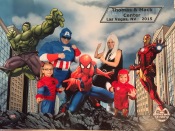Horizon v. Marvel: Copyright in the Three-Point Landing?
I love copyright law, usually. Why is it there? It is there to ensure that authors and artists can profit from their work. Great idea.
Unfortunately, somewhere along the line, the concept got polluted. Originally, copyright protected works for 14 years, with a renewal period of 14 years. After a number of changes, we’re now up to a term that is the entire lifetime of the artist plus another 70 years. Nuts. This has created all kinds of problems with “orphaned works” — works that nobody publishes, people want to read, but they can’t — because copyright.

Don’t get me wrong, these are not what you would call “frivolous” claims. Why not? Because they work. Federal courts have increasingly provided such expansive interpretations of copyright protection, that it is a big welcome mat to anyone with one of these expression-stifling claims. For example, the law surrounding sampling has really grown out of proportion. And, the recent “Blurred Lines” case shows where copyright has run amok. (For more, read The Asshat in the Rye)
Well, here we go again. In this circumstance, we have an infringement case involving Marvel Comics — and comic books, almost by design, use common ideas and themes all the time. In a recent complaint, we have essentially a claim based on the “three point landing”. See Horizon Comics Prod. v. Marvel Ent., LLC, No. 15-11684 (Mass. Apr. 23, 2015).
Horizon Comics, owned by the Lai brothers who also happen to be employees of Marvel, asserts that Marvel’s reinvention of the Iron Man character in its 2013-2015 theatrical releases infringes upon and undermines their copyright in characters from the Horizon comic Radix, originally released in 2001. Horizon claims that Marvel, without permission, took its (grey, mind you) fully armored suits and fitted them for the new Iron Man (red and gold) look, as “ the comic typically depicted Iron Man wearing simple spandex-like attire and minimal armor.” Id. at 11. Horizon further contends that it claims copyright on the three point landing. Perhaps in the future they would narrow this to the three-point landing specifically while wearing armor and leaning on their left hand , though that certainly wouldn’t be original enough either. In any case Horizon seeks redress against Marvel’s theft of the “fully mechanized suit of body armor” and the three-point landing depicted in the Iron Man Movie Poster.
Neither mechanized body armor nor the three-point landing are new to the comic world. For armor, characters of note may include Master Chief from Halo, Batman, Transformers, and perhaps the Pacific Rim comic release that coincided with the movie in 2013. Horizon seeking to profiteer here would mean that they could, I suppose, seek redress against DC for Superman’s occasional adaptation of the pose, or other places in the Anime realm including characters from Kuogane Pukapuka Tai and Naruto (which has been around since 1997). Although one may think to consider that three-point landings of note include Black Widow and Spiderman, both Marvel characters begs the question does Marvel favor the three-point stance, and did this fancy come about after Lais’ involvement?
Either way, the three-point stance and the armored wardrobe cannot so simply be claimed by the Lai brothers. We should reflect on this as an example of how not to use our lawyering super powers to crush the comic realm into copyright compliance. Copyright indeed should, though it doesn’t always, cover creative and novel characters in comics, books, and movies, though we must draw the line at common tropes used to further artistic invention.
The Three Point Landing is such a cliché at this point that I hardly think it could be deemed copyrightable. See, e.g., Herzog v. Castle Rock Entertainment, 193 F.3d 1241 (11th Cir. 1999) (holding that plaintiff failed to establish substantial similarity between two films portraying detectives investigating murder in small town. The court reasoned “scenes a faire, ‘sequences of events which necessarily follow from a common theme,’ are not protectable.”)
Unfortunately, this case shows where the problem lies with copyright. I’m no copyright abolitionist. I think that real infringement should be hit with real penalties. But, cases like this are the cancer within copyright — the cancer that threatens to eat creativity. The cancer that threatens to use copyright law to stifle free expression.
It deserves a POW! right in the face.
[youtube=https://www.youtube.com/watch?v=mgOtPXDyKjA]

